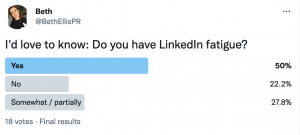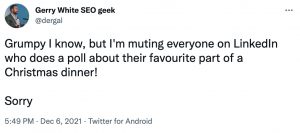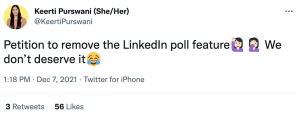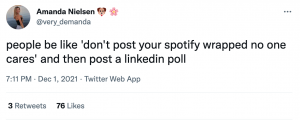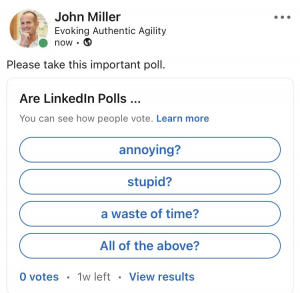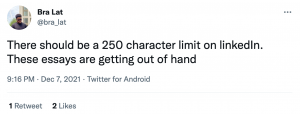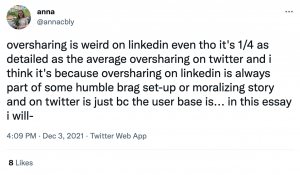Do We Have LinkedIn Fatigue?
At a friend’s gathering few months ago, I was talking with a group of people I’d never met before, and the conversation turned to what we all did for work. After the polite exchange of questions (a lot of “so what does that entail, exactly?”) someone happened to mention LinkedIn.
Immediately following the L word, a unified groan came from just about everyone in the circle. People were immediately eager to poke fun of the typical kind of viral content LinkedIn tends to promote, or produce; complaints of the kinds of somewhat-influential people you tend to come across on there; and the general assent that LinkedIn had become ‘like Facebook, but worse.’
What happened? If someone had mentioned Twitter, Instagram, or even Facebook itself, I highly doubt such an adverse reaction would have followed. Everyone, it seemed, was of the same mindset: that LinkedIn was a hive of content that quite often ranged from the pretentious to the irritating. But, either due to its useful aspects of connecting with co-workers, industry minds and old friends, or needing to be on the platform for work, people remained on there, regardless.
Only Connecting
You could fairly argue this anecdotal example doesn’t necessarily reflect a wider attitude. But, recently, more and more complaints about the way in which LinkedIn users utilise the platform seem to have been ever-louder. On Twitter, I put out a small poll to see if this was just a one-off example, and found that my friends weren’t alone in this feeling.
Of the respondents, nearly 80% responded with either ‘Yes’ or ‘Somewhat / partially.’
So why have people become disillusioned with the website, which, according to its database, has over 800 million users? I’ve come up with some potential reasons: perhaps they’ll ring true for you, too…
-
Pointless Polls
As anyone who works in social knows, polls are a fail-safe way to engage with followers, widen your reach/presence, and, of course, find out the actual opinions of those who read your content.
But over the past year or so, polls have been cropping up on LinkedIn that have little or nothing to do with the more traditional topics – business, thought leadership, work culture, wages, diversity, and inclusion, to name just a few – and have instead been taken over by polls that are a transparent effort for the user in question to broaden their reach. These polls are reminiscent of Facebook, in that the question is usually either a) a controversial or semi-controversial topic, or, b) about food (of course!).
While it’s certainly harmless to ask what people like for their Christmas dinner, this is the kind of content we’re all used to seeing on Twitter, Instagram, Facebook – basically, every single platform other than LinkedIn. Why use a platform primarily created with business networking, job-seeking and careers in mind to run a poll about something completely irrelevant?
What might have started as a fun exercise in getting gaining audience interaction has now become something users regularly complain about.
There’s also the opposite end of the spectrum to consider: polls that aren’t about a harmless topic could alienate employees from their employers, and vice versa. Some LinkedIn polls have called for opinions on masks, COVID restrictions, and the relatively new ‘office vs working from home’ debate. Let’s say your boss is vehemently against employees working from home, but you’re doing your best to manoeuvre a more 50/50 arrangement – it wouldn’t be fun to see them react to sensitive topics that have caused tension in the office. Right?
2. Barely Concealed Bravado
Of course, there’s absolutely nothing wrong with sharing achievements, promotions, or personal wins – it’s practically what social media was invented for. And being a platform designed to bring professionals together, our LinkedIn feeds are bound to be full of people sharing their good news stories – which is great, especially in these uncertain times.
However, some use the opportunity to share good news as a chance to write essay-long posts that string out the meticulous details of the good deed, the profit, or the yearly roundup as lengthily as possible. What’s worse is that the algorithm seems to preference these sorts of posts… So, of course those looking to expand their LinkedIn reach will utilise this preference by the site.
It’s always lovely (and interesting!) to read others’ big wins, moments of generosity and acts of kindness – but, similarly to the way in which constantly using Zoom will have us grimacing at the sight of our own faces after a long few days or weeks of back-to-back meetings, the fatigue caused by overly-long essays make me tune out – and I don’t think I’m alone in that.
3. Ostentatious Oversharing
Topics of a sensitive nature don’t have any one natural home on social media. Celebrities using the iPhone notes app and posting apologies, bad news, or heartfelt sincerity on Twitter have long been ridiculed for the practice – which may or may not always be a fair criticism.
Facebook and Instagram may be the more typical place for those wishing to share their grievances in life or the world: in the thick of Black Lives Matter protests last year, inarguably a topic sensitive for many, Instagram infographics were doing the rounds like wildfire. Whether it was statistics on police brutality or a snapshot of the incident that started it all – the murder of George Floyd – Instagram had become a hub of ‘PowerPoint activism,’ a term used by Vox. Where once the app was host to little more than selfies, holiday snaps and brunch, it’s now not unusual to see posts and stories of a sensitive nature across your timeline.
When it comes to LinkedIn, however, it’s a different kettle of fish. Do people using a B2B networking platform really want – or need – to see the topics of a sensitive nature that seem to be more and more frequently shared? Furthermore, intimate, or personal details are one thing, but it’s quite another when it comes to photos of other people’s children with terminal illness, neurodivergence or disabilities. Did everyone involved give their full permission to have their photo, and story, spread over the internet to potentially hundreds, if not thousands of people?
It must be said that there is a level of catharsis achieved when posting this sort of content. And if those reading the posts on their timelines garner some sympathy for those in a similar position, then it’s been a fruitful exercise – we could all do with a little more kindness, after all.
One positive of the overhaul of attitude towards mental health is that we’re all becoming a little more open, honest, and vulnerable about our struggles and day-to-day hang ups. It takes an immense amount of strength to write about your personal issues for all the world to see. There’s a time and a place, however – and I’m not sure LinkedIn is that place. I’m certain that it’s not the place when it comes to the struggles of those who are in more vulnerable positions than us, too.
To Sum Up
I promise I’m not so cynical as to not see the great things about LinkedIn. It can be a wonderful platform, and I’ve taken a lot of inspiration from seeing others’ tips and tricks, mental health championing and career achievements. Particularly through the pandemic, I found that LinkedIn was a place where those in similar industries and environments were able to vent, share their anxieties, and help brainstorm on what the future of ‘traditional work’ might look like.
However, with such a negative name for itself at the moment, the platform needs to decide what it wants to be: a Facebook-style free-for-all in which anyone can post their thoughts (work-related or not), or a platform for strictly business-related matters.
What are your thoughts? We’d love to hear them! Get in touch via our Facebook, Twitter or Instagram.
Photo by Tara Winstead from Pexels


